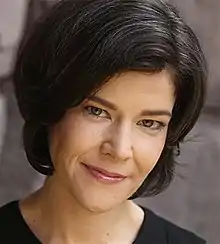Nicole C. Rust
Nicole C. Rust is an American neuroscientist and an Associate Professor of Psychology at the University of Pennsylvania. She studies visual perception and visual recognition memory. She is recognized for significant advancements in experimental psychology and neuroscience.[1]
Nicole C. Rust | |
|---|---|
 | |
| Alma mater | University of Idaho New York University Massachusetts Institute of Technology |
| Known for | Visual Perception, Visual Recognition Memory |
| Awards | Troland Research Award, McKnight Scholar, NSF CAREER Award, Sloan Fellow |
| Scientific career | |
| Fields | Neuroscience, Psychology |
| Institutions | University of Pennsylvania |
| Academic advisors | J. Anthony Movshon Eero P. Simoncelli James DiCarlo |
| Website | www |
Rust was the recipient of the 2021 Troland Research Award from the National Academy of Sciences for her fundamental contributions to understanding how the cortex makes use of complex visual information to guide intelligent behavior.[2] She was named a McKnight Foundation Scholar (2013),[3] received an NSF CAREER Award (2013)[4] and was named an Alfred P. Sloan Research Fellow (2010).[5]
Education and early career
Rust received her bachelor's degree in from the University of Idaho in 1997.[6] She then went on to receive her PhD in Neuroscience from New York University in 2004 under the mentorship of J. Anthony Movshon, and Eero Simoncelli.[7] There, her work focused on how the primate brain processes information about visual motion, including in the primary visual cortex[8] and area MT.[9]
Career and research
Rust completed postdoctoral research at the Massachusetts Institute of Technology between 2004 and 2006. There she worked under the mentorship of James DiCarlo, studying how the brain identifies the objects that are present in a visual scene.[10]
Rust joined the faculty in the Department of Psychology at the University of Pennsylvania in 2009. Her lab has focused on understanding how the brain uses visual information to solve different tasks, including finding sought objects[11] and remembering the images that have been encountered.[12]
References
- "Academy honors 20 for major contributions to science". www.eurekalert.org. Retrieved 2021-01-24.
- "20210 Troland Research Award". nasonline.org. Retrieved 2021-01-24.
- "McKnight Scholar Awardees". www.mcknight.org. Retrieved 2021-01-24.
- "NSF CAREER Award Abstract #1265480". nsf.gov. Retrieved 2021-01-24.
- "Past Sloan Fellows". sloan.org. Retrieved 2021-01-24.
- "Nicole Rust Biography". sas.upenn.edu. Retrieved 2021-01-24.
- "Simons Foundation". simonsfoundation.org. Retrieved 2021-01-24.
- Rust, NC; Schwartz, O; Movshon, JA; Simoncelli, EP (2005). "Spatiotemporal Elements of Macaque V1 Receptive Fields". Neuron. 46: 945–956. doi:10.1016/j.neuron.2005.05.021.
- Rust, NC; Mante, V; Simoncelli, EP; Movshon, JA (2006). "How MT cells analyze the motion of visual patterns". Nat Neurosci. 9: 1421–31. doi:10.1038/nn1786.
- DiCarlo, JJ; Zoccolan, D; Rust, NC (2012). "How does the brain solve visual object recognition?". Neuron. 73 (3): 415–434. doi:10.1016/j.neuron.2012.01.010.
- Pagan, M; Urban, LS; Wohl, MP; Rust, NC (2013). "Signals in inferotemporal and perirhinal cortex suggest an untangling of visual target information". Nature Neuroscience. 16: 1132–1139. doi:10.1038/nn.3433. PMC 3725208.
- Meyer, T; Rust, NC (2013). "Single-exposure visual familiarity judgments are reflected in IT cortex". eLife. 7: e32259. doi:10.7554/eLife.32259.